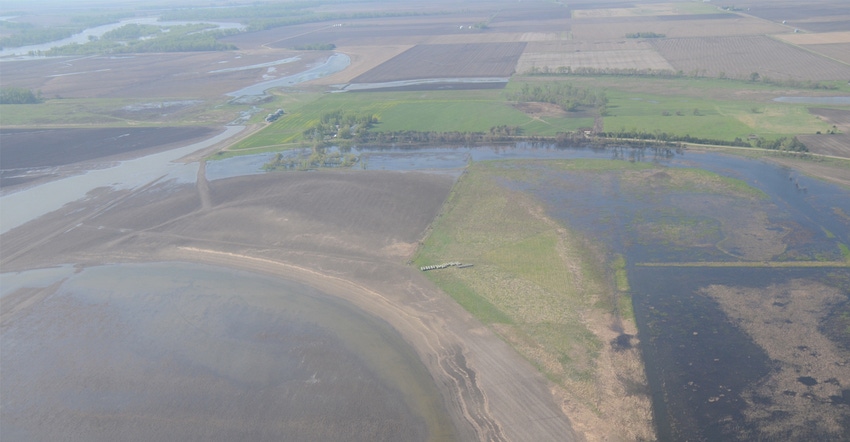September 14, 2021

In a sudden turn of weather events, there have been several severe storms in the northeast and east central crop reporting districts of Iowa. These storms have created the potential for grain quality problems; the problems needing the most immediate action are those corn and soybean fields that have been flooded above the grain level. Fields with lodging will have more grain susceptible to flooding.
Of the storm-related quality issues, flooded grain needs the most immediate action. With both crops nearing maturity, quick decision-making will aid in determining whether any of the crop can be salvaged.
When grain is considered adulterated
Grain submerged by uncontrolled floodwaters is considered adulterated under the Food, Drug and Cosmetic Act. This policy dates to 2008, when grain storage in Cedar Rapids was inundated, and has been applied to several situations since then. Adulterated material cannot be put in commercial facilities of any type where there would be a chance of the grain entering human or animal food. The Food and Drug Administration updated its flooded food guidance on Sept. 17, 2018. Both corn and soybeans are considered food crops.
The FDA makes a specific distinction between uncontrolled waters (streams, rivers, etc.) and isolated low places in fields. The guidance states, "Flooding is the flowing or overflowing of a field with water outside a grower's control. Pooled water (after rainfall) that is not reasonably likely to cause contamination of the edible portions of fresh produce is not considered flooding." Uncontrolled flowing water may have picked up contaminants, while ponds in low places are less likely to do so.
All crops in which the grain was submerged are considered adulterated. This would include grain from fields that had shorter plants flooded but not taller ones, if both were harvested together. The first step in defining what areas of a field might be subject to the flooded grain rules would be a consultation with your crop insurance carrier.
For any adulterant, however, there is provision for the holder to ask the FDA to approve a reconditioning plan. In Iowa, the contact point for the FDA is the Iowa Department of Agriculture and Land Stewardship’s Feed and Fertilizer Bureau. This process may take considerable time and effort. The likely outcome would be use for local animal food, after drying and extensive testing. Unfortunately, the area of Iowa most affected by flooding this year is also the area of most dairy production. Dairy cows are very sensitive to mycotoxin transmission to milk. Adulterated grain should never be fed to dairy animals, and only to other types of livestock after a documented on-farm livestock feeding plan is approved by a veterinarian.
Potential hazards
The FDA has provided a list of potential hazards in flooded grain in the guidance referenced above. Mycotoxins, heavy metals, pathogenic organisms, pesticide residues and polychlorinated biphenyls are the main concerns. The Iowa State University Veterinary Diagnostic Laboratory, accessible through any veterinarian in Iowa, is one source of testing and support.
Grain not flooded but near the floodwater on partially submerged plants is subject to testing for contaminants based on a risk-based evaluation of the specific situation (on a case-by-case basis). This places the responsibility for the risk assessment on the producer. Discuss the situation with crop insurance and liability insurance carriers. Document any decisions made as clearly as possible — how much area, what did you do, why, etc. This would also apply to cases where there is differentiation between flowing-water inundation and low-ground ponding. Food safety regulations are now very reliant on documentation of actions and reasoning.
Grain elevators and grain processors should be aware of any flooded grain situations in their trade areas. Because flooded grain is adulterated, this grain should neither be offered for sale nor knowingly taken into a commercial facility. Processors have flooded grain as one of the reasonably foreseeable hazards being controlled in their food safety plan under the Food Safety Modernization Act. Without an approved reconditioning plan, this grain is effectively a total loss, with no portion recoverable from the market.
Hurburgh is a professor of agricultural and biosystems engineering at Iowa State University. Michel, Vittetoe and Anderson are Iowa State University Extension and Outreach field agronomists.
Source: ISU Integrated Crop Management News, which is responsible for the information provided and is wholly owned by the source. Informa Business Media and its subsidiaries aren't responsible for any of the content contained in this information asset.
You May Also Like




